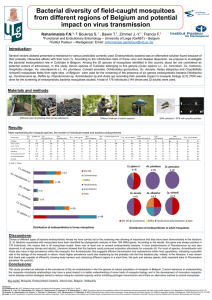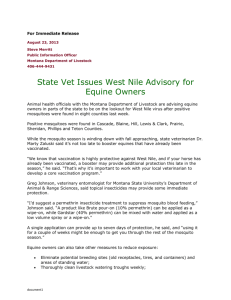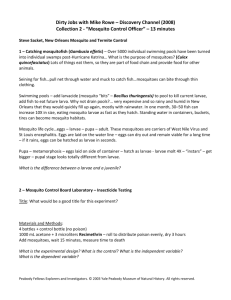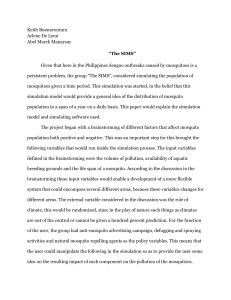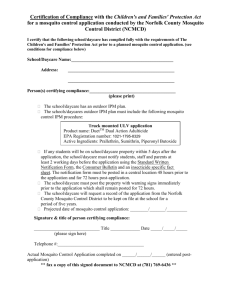JUNE 2015 ag Newsletter
advertisement
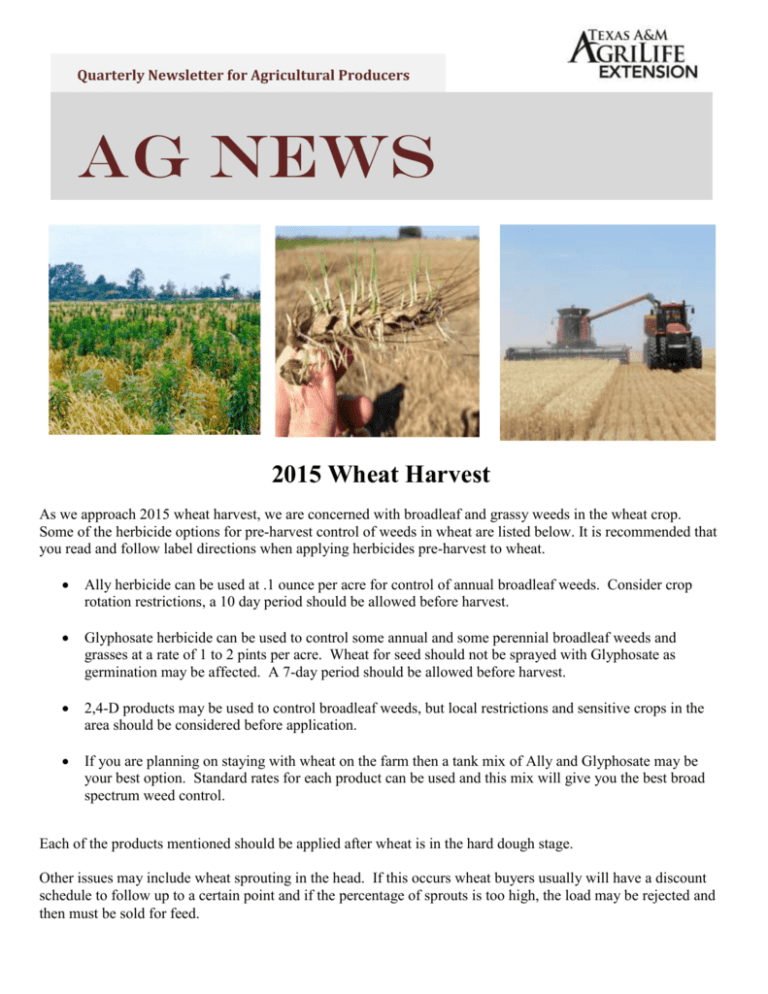
Quarterly Newsletter for Agricultural Producers Ag News 2015 Wheat Harvest As we approach 2015 wheat harvest, we are concerned with broadleaf and grassy weeds in the wheat crop. Some of the herbicide options for pre-harvest control of weeds in wheat are listed below. It is recommended that you read and follow label directions when applying herbicides pre-harvest to wheat. Ally herbicide can be used at .1 ounce per acre for control of annual broadleaf weeds. Consider crop rotation restrictions, a 10 day period should be allowed before harvest. Glyphosate herbicide can be used to control some annual and some perennial broadleaf weeds and grasses at a rate of 1 to 2 pints per acre. Wheat for seed should not be sprayed with Glyphosate as germination may be affected. A 7-day period should be allowed before harvest. 2,4-D products may be used to control broadleaf weeds, but local restrictions and sensitive crops in the area should be considered before application. If you are planning on staying with wheat on the farm then a tank mix of Ally and Glyphosate may be your best option. Standard rates for each product can be used and this mix will give you the best broad spectrum weed control. Each of the products mentioned should be applied after wheat is in the hard dough stage. Other issues may include wheat sprouting in the head. If this occurs wheat buyers usually will have a discount schedule to follow up to a certain point and if the percentage of sprouts is too high, the load may be rejected and then must be sold for feed. Page 2 Ag New s 2015 Cotton Crop As we begin to dry out from what has been a record setting May rainfall event we should consider a few things as we begin planting the 2015 cotton crop Variety selection is an important consideration when planting June cotton. Seed representatives and gins should be contacted to determine what short-season varieties are available and what seed treatments are available. If possible an insecticide treatment for thrips should be selected to prevent delays in maturity caused by thrips. Other considerations to promote earliness are to reduce the likelihood of herbicide damage by making sure spray tanks are clean from residual herbicides before spraying cotton especially 2,4-D type products. Do not over apply Nitrogen fertilizer. One bale of cotton requires about 50 pounds of Nitrogen. Excessive Nitrogen can lead to excessive plant growth and delayed maturity. The use of Meqiquat chloride (Pix, Mepex, Mepex Ginout, Stance, etc.) can impact earliness through fruit retention and 3 to 5 days earlier cutout. Do not use on cotton that is stressed or will become stressed soon because this could delay maturity. Residual herbicides should also be considered such as Prowl, Warrent, Caporol and Trifluralin. These residual herbicides are still affective on pigweed and should help with early season weed control. What burn down herbicide should be considered before planting? Recent reports of Glyphosate resistant weeds should have us considering other herbicide options for pre-plant burn down. Gramoxone, Aim, and Liberty are 3 non-selective grass and broadleaf control options. Please read labels and consider size of target weeds. Ag New s Page 3 What’s Next for the Beef Industry? The rally on May 29th in the CME cattle complex had a lot of whistles and bells. Volume in the cattle was 92k, the largest since early January and open interest surged 8.8k contracts to the highest level since November 25. Most cattle contracts reached the highest level since the first few days of 2015 and some charts illustrate an undeniable uptrend since February. Such is the situation when a heavily discounted futures market is combined with historically small supplies. Rally or no rally, bears are still arguing that heavy cattle weights and increasing seasonal supplies will bring the cash down this summer. Boxed beef values “normally” make a seasonal top this time of year and work lower into the dog days of summer before bottoming. A typical seasonal decline would put choice boxes in the mid $240s by July/August. However, seasonals have not been nearly as reliable in the past year or more due to multiple factors including voracious and unexpected demand for certain cuts. Yesterday, choice boxes dipped to $259.25, about $5 off the all-time high and predictions are widespread more is to come. Since packer margins typically are black throughout the summer there is an assumption by some analysts and traders that packers will be black as beef prices sag-meaning of course that fed cattle prices will decline. Based on the most recent quarterly revenue reported, packers are faring much better than some simulated packer p&l’s used by some in the industry. The only way to get a somewhat accurate view is to simulate packer margins using the comprehensive cutout released by USDA each Monday which includes all the way packers sell beef, not simply spot sales. Then compare those results to quarterly results. Certainly packers lost money on U.S. beef operations during Q1 2015, just not as much money as believed at the time. And packers have done a brilliant job not over killing when they have had margin, mindful of the fact that 2015 cattle supplies overall are tight. In fact, they’ve weathered the “tight supplies” storm generally much better than expected. So what does this mean for the market? Well packers need to buy cattle for next week’s kill, though they will fight hard to avoid paying any more than steady with last week, $159 north and $161 south. Futures at this writing have not taken out yesterday’s highs and traded both sides of steady. No doubt the impressive performance wielded by futures yesterday has bulls taking some profits and bears saving their bullets for the close. The cash trade looks to occur after futures close, with a very big line drawn in the sand. This Information can be found on www.thebeefread.com by Cassandra Fish. Page 4 Ag New s AgriLife Extension experts: Texans should expect mosquito population explosion Residents can help control, protect themselves from mosquitoes Anticipating a significant increase in the state’s mosquito population, Texas A&M AgriLife Extension Service entomologists are offering tips on how Texans can help slow mosquito breeding in backyards and protect from being bitten. “Mosquito populations are booming throughout the state and will likely not go away anytime soon after all our rains and flooding,” said Dr. Mike Merchant, AgriLife Extension urban entomologist in Dallas. “Not all of the mosquitoes swarming us right now are likely to carry disease, but West Nile virus-infected mosquitoes are beginning to show up in traps.” The Asian tiger mosquito shown here is one of the two mosquito species known to commonly transmit the chikungunya virus. The other is the closely related yellow fever mosquito. Both species are found in Texas. (Texas A&M AgriLife Extension Service photo by Dr. Mike Merchant) Texas Department of State Health Services recently announced the first 2015 case of West Nile virus in the state, and Dallas County Health and Human Services just issued a health advisory reporting its first positive mosquito pool of the year. Merchant added that chikungunya, another disease transmitted by mosquitoes, is on the radar of U.S. and state health officials as a growing concern. He said the virus is regularly brought into the U.S. by travelers, but as yet a human-to-mosquito-to-human cycle has not developed in Texas. “This could change, however, as it did last year in Florida where a handful of cases occurred among Floridians who had not traveled to the Caribbean,” Merchant said. “The principal mosquito vectors of chikungunya include the Asian tiger mosquito, Aedes albopictus, and its close relative, the yellow fever mosquito, Aedes Page 5 Ag New s aegypti. Chikungunya frequently comes with a very bad headache, joint pain, rash and fever. There is no treatment for or vaccine to protect from this disease.” For more information about where mosquitoes can breed, and how to identify Aedes and other mosquitoes, Merchant suggested going to AgriLife Extension’s Mosquito Safari website, http://mosquitosafari.tamu.edu. Humans are not the only ones to suffer from mosquito-borne diseases, AgriLife Extension experts noted. “Mosquitoes can also be vectors for dog heartworm,” said Dr. Sonja Swiger, AgriLife Extension livestock/veterinary entomologist in Stephenville. According to Swiger, an infected mosquito can pass tiny heartworm parasites on to any uninfected dog it bites. Heartworm causes lasting damage to heart, lungs and arteries, and can affect the dog’s quality and length of life. In addition, horses are susceptible to several encephalitis diseases, including West Nile virus, and should be vaccinated every year. Swiger said that to control mosquitoes effectively and economically, everyone should understand their basic life cycle and be familiar with the important mosquito types. According to Swiger, mosquitoes can be divided into two groups based on where they lay their eggs. For example, floodwater mosquitoes lay eggs on the ground in low spots, and these eggs hatch when it rains and the low area fills with water. “With the unusually high May rainfall, these mosquitoes are common now and likely to remain so during the duration of the rain,” she said. “Floodwater mosquitoes are good fliers and can travel many miles from their breeding sites in temporary pools, roadsides and low lying areas.” She noted there is little people can do on their own property to protect themselves from floodwater mosquitoes, other than stay indoors or wear repellent. “We have more control over other mosquitoes that breed in containers and live closer to town,” Swiger said. “Container breeding mosquitoes include some of the most significant species that may negatively affect human health, including the common house mosquito.” The entomologists referred to what they called “the four D’s” as a general means for people to help manage mosquitoes and protect against bites. These are: — Dusk/Dawn – Avoid being outside when mosquitoes are searching for a blood meal, which is usually in the early morning hours and just before the sun goes down. While some species are daytime biters, most prefer to feed at dusk and dawn. — Drain – Empty standing water from “containers” around your home and work areas, such as buckets, wheelbarrows, kiddie pools, toys, dog bowls, water troughs, tires, bottles, etc. Make improvements that allow standing water to run off following rains. — Dress – If out during mosquito feeding hours, wear long sleeves and pants in plain colors. Avoid attracting them by wearing excessive amounts of perform or aftershave. — Defend – Any time you go outside for an extended period of time, wear an insect repellent. Page 6 Ag New s Dr. Charles Allen, AgriLife Extension Entomology Program Leader in San Angelo, said mowing tall weeds and grass can help eliminate some mosquito resting areas. Texas A&M AgriLife Extension Service Foard County PO Box 669 Crowell, TX 79227 Phone 940-684-1919 Fax 940-684-1918 E-mail foard@ag.tamu.edu “When mosquito populations are high, labeled contact insecticides can be used to knock down adults,” he said. “For greatest effectiveness, sprays should be directed to shady mosquito resting areas. In addition, insecticidebased misting systems can be effective short-term, but repeated applications can cause insecticide resistance or be harmful to non-target insects and may result in loss of control. These systems are most likely to be effective if timers are set to spray when mosquitoes are most active.” Allen said there are also techniques that can help control larval stage of mosquitoes in water. “Mosquito dunks containing insect growth regulators or Bti, the mosquito larva’s bacterial natural enemy, can be used in water that cannot be dumped or drained to reduce mosquito populations,” he said. Products that apply a surface film or oil on the water can also be used to reduce larval mosquito and pupal populations by preventing them from getting air through their breathing tubes, he said. The use of films or oils should be limited to locations without any other organisms, since it will prevent oxygen to the non-target organisms as well. According to Merchant, insect repellent is still the best overall defense against those “less savory insect and mite biters.” “I always suggest people keep a bottle or can of repellent just outside their doorway to remind them to spray exposed skin, even if they plan to e outside just a short while,” he said. “Keeping repellent in your car is a very good idea too.” The entomologists agreed that repellents with DEET remain the gold standard for protection. “DEET has some of the best persistence. However, there are good alternatives to DEET if you aren’t going to be outside very long,” Merchant said. “The natural repellent, oil of lemon eucalyptus, is a good alternative to DEET for those who prefer an organic product. The most important thing is to find a repellent that works for you and to use it.” Merchant periodically posts news updates on mosquito activity on his City Bugs website, http://citybugs.tamu.edu. He also has developed four short videos on different aspects of mosquito control that can be found at http://bit.ly/1F8cZkg.

